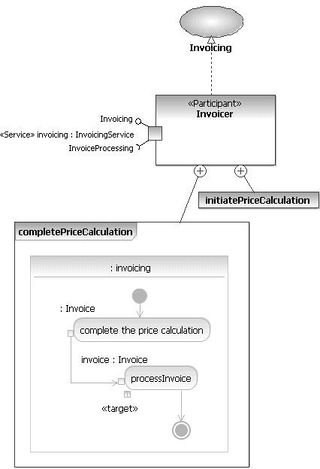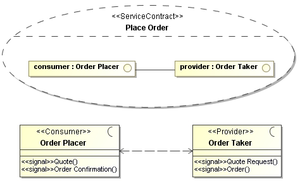Service
The OASIS SOA Reference Model states:
The noun “service” is defined in dictionaries as “The performance of work (a function) by one for another.”
Service in SoaML
A Service represents a feature of a Participant that is the offer of a service by one participant to others using well defined terms, conditions and interfaces.
Contract
- The complete description of a service from a consumer’s point of view (signature and semantics) is called a “well-defined interface” or “contract.”
- A contract is agreed individually between a certain provider, and a certain consumer, and usually includes nonfunctional aspects such as SLAs.
SLA
- ABA (Abandonment Rate): Percentage of calls abandoned while waiting to be answered
- ASA (Average Speed to Answer): Average time (usually in seconds) it takes for a call to be answered by the service desk.
- TSF (Time Service Factor): Percentage of calls answered within a definite timeframe, e.g. 80% in 20 seconds.
- FCR (First Call Resolution): Percentage of incoming calls that can be resolved without the use of a callback, or without having the caller call back the helpdesk to finish resolving the case.
- TAT (Turn Around Time): Time taken to complete a certain task.
- Uptime
ServiceContract in SoaML
- A ServiceContract is the formalization of a binding exchange of information, goods, or obligations between parties defining a service.
- A ServiceContract is the specification of the agreement between providers and consumers of a service as to what information, products, assets, value and obligations will flow between the providers and consumers of that service – it specifies the service without regard for realization, capabilities or implementation.
Services and Business Functionality
- Services Represent Business Functionality
- SOA is focused on business processes
- “natural” step of business functionality
- self-contained (explained later)
- business people should be able to understand what a service does
Interfaces and Contracts
- Service is an interface for messages that return information and/or change the state of an associated entity (backend)
- “interface-oriented architecture.”
Interfaces in SoaML
- Provides the definition of a service.
- Defines the specification of a service interaction as the type of a «Service» or «Request» port.
Business vs Technically Driven Interfaces
Technically Driven Interfaces
customerOP(action, // "create", "read", "change", "delete"
id, // customer id or null
name, // new customer name or null
address, // new customer address or null
account) // new customer bank account or null
Business Driven Interface
createCustomer(name, // new customer name
address, // customer address
account) // customer bank account
readCustomer(id) // customer id
changeCustomerAccount(id, // customer id
account) // new customer bank account
changeCustomerAddress(id, // customer id
address, // new customer address
check, // true: verify address
modify) // true: fix address if possible
deleteCustomer(id) // customer id
Service Attributes
- Do services have to be stateless?
- Do they have to be implemented as Web Services?
- Should they be coarse-grained and/or composable?
Coarse-Grained
- Services are abstractions that hide implementation details from the consumers
- The price for the abstraction is performance
- There is no clear definition of “coarse-grained” service
Visible/Discoverable
- Services must be searchable
- Usually there is some kind of catalogue and taxonomy (see UDDI)
Stateless
There is always some state involved
- Technical state
- Business state
Idempotent
- Whether we can call the service many times (for example in case of no response) without risking doing the thing twice
- Idempotency is the ability to redo an operation if you are not sure whether it was completed
- Changing status function may be ideponent
- SwitchStatus() versus setActive()
Reusable
- Avoiding redundancy is a general goal of software development
- Ideally each functionality should be implemented only once
- It may cause performance issue
- As a result, reusability may be a goal, but not a rule
Composable
- Services can use/call other services
- Discussed further in BPM section
Other attributes
- Technical (reusing the infrastructure)
- QoS- and SLA-Capable
- Pre- and Post-Conditions
- Vendor-Diverse
- Interoperable
Questions
- What does the “well-defined interface” or “contract” contain?
- What does a typical SLA contain?
- What does it mean composable?
- What does it mean idempotent?



